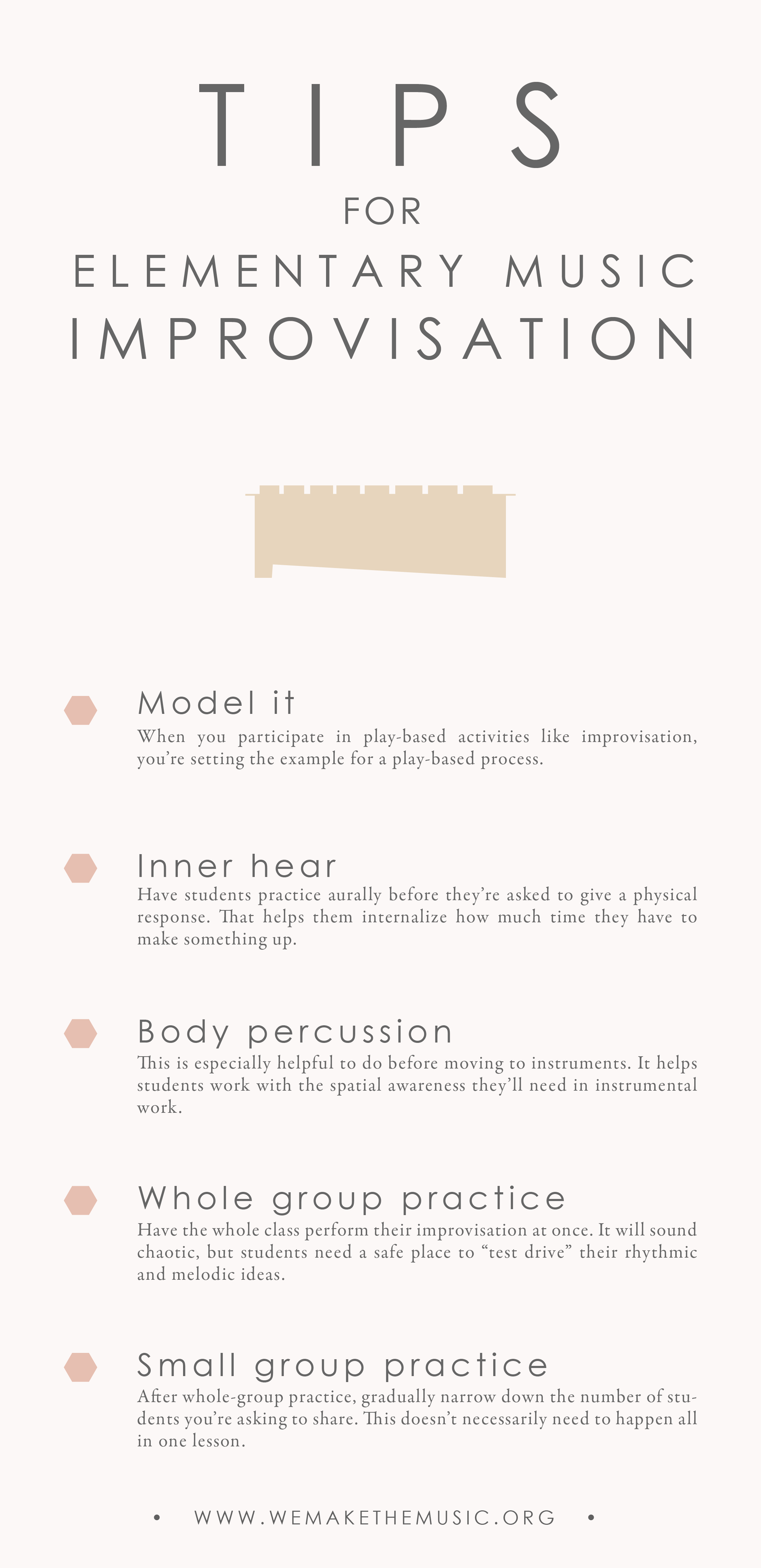Improvisation Tips for Elementary Music
Improvisation is one of the best methods we have for figuring out how our students are working through musical materials. That’s because the cognitive process in improvisation requires students to build upon previous knowledge to create something new. Improvisation is also spontaneous, so students generate this new material in the moment. Spontaneously generating new musical material based on previous understanding is an impressively advanced skill!
There are different kinds of improvisation activities that your students will find valuable. They range from open-ended, free activities (like a young child “playing around” on a metallophone), to highly structured in their form, melodic content, and meter (like a vibraphone player improvising over a 12-bar blues progression).
These tips apply to structured improvisation. That means that you are putting some parameters around the form you want the improvisation to take. The exact parameters you’ll use will depend on your students, their musical abilities, and your unique educational goals.
1. Prerequisites for Improvisation:
Improvisation is an aural skill. Students will need lots of experience and understanding of the musical element before they’re asked to improvise with it. This includes singing, speaking, playing, reading, writing, listening, and analyzing. In addition, here are two important prerequisites to think about:
Audiation:
In improvisation, students must draw conclusions about music based on their understanding of music’s structure. Students are essentially making guesses about what musical pairings will sound good together. For this to work well, they need an established tonal, rhythmic, and structural landscape.
Tonal Patterns and Vocal Improvisation:
Vocal improvisation is a particularly challenging task because of how much preexisting aural skills it takes. When they improvise vocally, students draw on tonal patterns. If a collection of tonal patterns are not secure (for example, m r d; mm r d; m rr dd d), students will have limited success with vocal improvisation.
Students need a strong aural foundation before they’re ready to tackle improvisation
2. Strategies for Successful Improvisation
Improvisation is wildly rewarding and fun, but it can also be intimidating. Here are some of my favorite ways to scaffold the process:
Model it:
It’s not surprising that students experience more success with improvisation when their teachers model it for them. When you provide a model, students see that their answers don’t need to be elaborate or complex. It takes some of the pressure off to hear examples of what the teacher considers to be “good” improvisation. Also, if students see you as a creative agent, they’re more likely to engage in creative activities themselves. When you participate in play-based activities like improvisation, you’re setting the example for a play-based process.
Think it in your head:
Have students practice aurally before they’re asked to give a physical response. That helps them internalize how much time they have to make something up. In my experience, improvising within a metered time constraint (phrase) is the most challenging aspect for students. I recommend having students pat the steady beat as they inner hear the phrase to reinforce the amount of time they have to improvise.
Body Percussion:
Before playing instruments, I almost always have students improvise on body percussion. This is a valuable scaffolding strategy that helps students internalize the spatial awareness they’ll need on instruments. Jumping straight to instruments works with some activities and some students, depending on their musical skill level. However, when in doubt, I find it’s best to add this extra step.
Group Practice:
Have the whole class perform their improvisation at once. It will sound chaotic, but students need a safe place to “test drive” their rhythmic and melodic ideas.
Small Group Practice:
After an aural and group practice, ask half the class to share their improvisations at the same time. Then switch. Gradually narrow down the number of students you’re asking to share. This doesn’t necessarily need to happen all in one lesson.
Scaffold the process before you ask students to share their ideas
3. Improvisation Success and a Culture of Creativity
The amount of teacher-driven versus student-driven activities in your classroom will impact how your students handle improvisation activities.
If students are used to you making all the musical decisions (what to sing, what to read, how to perform, how many times to repeat, etc) and simply following musical directions, they may not be comfortable jumping straight into improvisation.
If the teacher does all the thinking, and the students are only responsible for doing what the teacher says, the creative ownership rests solely on the teacher. This may make for a tricky transfer of ownership when the students are asked to do the thinking.
However, if students are used to having ownership over musical decisions like what instruments to use, how to move, what the form should be, and what parts should be included, they will be more comfortable with the innovation and creative thinking needed for improvisation.
You can read about how I use improvisation in my warm up routine here.
Strive for a culture of creativity instead of isolated creative activities.
The next post will be full of actionable ideas you can use to encourage creative improvisation in your classroom.
What are some of your favorite improvisation invitations?





